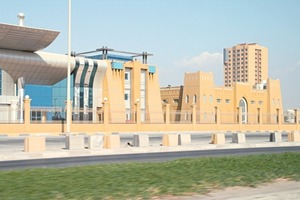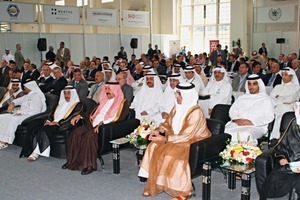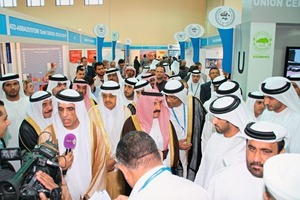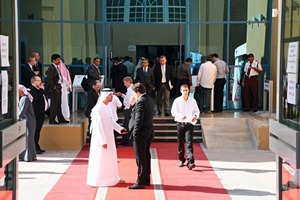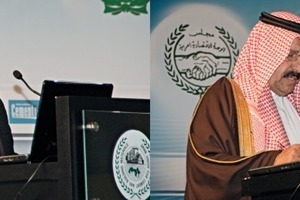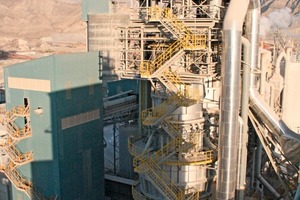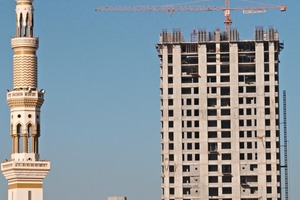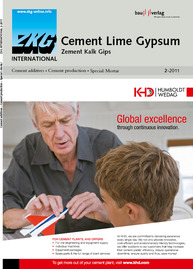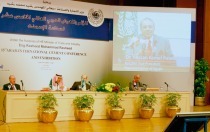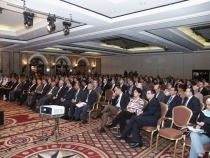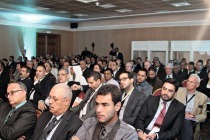Energy efficiency and reduction of emissions
in the focus
16. Arab-International Cement Conference and Exhibition, Ras Al Khaimah/UAE (06.–08.12.2010)
With more than 700 registered participants, the 16th Arab-International Cement Conference and Exhibition, which this time took place in the Ras Al Khaimah Exhibition Center (Figs. 1 and 2), was also a success this year. Following the inauguration ceremony (Fig. 3), the exhibition was opened (Fig. 4). More than 150 exhibitors presented themselves at their stands. The exhibition and the many technical and scientific lectures made the event once again an excellent networking platform (Fig. 5). ZKG INTERNATIONAL, which accompanied this and the previous events as media partner, was locally represented with a stand.
After the opening ceremony with Ahmad Al-Rousan (Fig. 6), General Secretary of the AUCBM, and HH Prince Sultan Bin Mohammed Bin Saud Al Kabir, AUCBM President, the lecture program started. The range of topics of the lectures was very comprehensive, though a few more listeners could have found their way to the conference hall. The first lecture was on the development of the cement industry in the UAE. Many construction projects had been put on ice during the last few years. After a long period of upturn, the branch was confronted with a drop in cement prices and a simultaneous rise in energy costs. Consequently, approaches had to be developed to maintain the long-term competitiveness. Thus, some companies changed from gas to coal firing and speeded up the use of alternative fuels, such as shredded tyres. In addition to kiln lines, there are also pure grinding plants. Green technology is an aspect that is becoming more and more important also in the United Arab Emirates. For the time being the UAE have a production capacity of almost 30 million tons. An important portion of the production is exported. At present the economy is again recovering.
The complete range of topics of the cement industry was dealt with in the lectures. For example, the POLAB Shuttle System from Polysius permits new degrees of freedom in laboratory automation. The first one has been installed in the Holcim Lägerdorf works in Germany. Sample robots, which can be moved on rails, transport the samples to various analysis systems even in parallel operation. ABB showed how ERP systems could be integrated into plant control, thus increasing the efficiency. Furthermore, new trends regarding clinker coolers (e.g. from FLSmidth and IKN) as well as innovative filter systems and materials (e.g. from Intensiv-Filter and Evonik Fibres) were presented. For example, IKN had installed clinker coolers for Union Cement that have proved to be low-maintenance at constant efficiency even after years of operation. FLSmidth showed that similar efficiency could also be expected of the Cross-Bar cooler, which has been continuously further developed within the last 13 years. However, up-to-date plant concepts for the production of dry-mix mortars consisting of large and small components were also presented (m-tec).
The topic ‘substitute fuels’ plays an increasingly significant role in the AUCBM conference program. Their possibilities of use and handling were dealt with in various lectures (amongst others, by Di Matteo Förderanlagen GmbH & Co. KG, FLSmidth Pfister GmbH, PEG SA, A TEC, MVW Lechtenberg, Cinar Limited). For example, A TEC showed how a farsighted selection of the feed points, accompanying modelling and other measures can minimize a negative influence of alternative fuels. Di Matteo presented the great variety of possible alternative fuels, from animal meal and municipal waste up to tyres and wood chips, as well as the involved demands on qualified bulk solid handling. With the NOVAFLAM®, Pillard presented the latest generation of burners for operation with 100 % substitute fuels. PEG S.A. proved that, in addition to alternative fuels, heat recovery plants may significantly contribute to a more positive energy balance and, consequently, lower CO2 emissions. Heat recovery systems may already pay themselves off after less than 5 years.
There are also new and efficient solutions in the field of refractory linings as regards the use of alternative fuels for special stress in the combustion space (e.g. ANKRAL QF from RHI) or a monolithic lining as time-saving as possible (amongst others, JETCAST® from Refratechnik). Furthermore, new approaches in grinding technology were presented. They range from innovative drive and gearbox solutions (e.g. the new WPV gearbox solution from FLSmidth MAAG Gear) up to current standards and new developments in the mill sector (e.g. the Comflex® system from KHD, the MVR vertical roller mill from Gebr. Pfeiffer AG). In the lecture from Loesche it was shown, amongst other things, how the comminution process has an effect on the microstructure and that the investigation of the material structure allows conclusions to be drawn as regards the grindability. Further main topics were the protection against wear (amongst others, Vautid, Kalenborn, Magotteaux), packing and logistics solutions (Möllers, FLSmidth Ventomatic, Haver & Boecker) as well as intelligent analysis tools (Panalytical, Sympatec, Iteca Socadei, Powitec), which also contribute in particular to process and quality monitoring when using alternative fuels.
Martin Schneider from VDZ (German Cement Works Association) gave an interesting lecture on the cement concepts of the future. In the last few years there was a great deal of movement towards research in the field of cements poor in clinker and cements with alternative, pozzolanic or latent-hydraulic raw materials. However, new cements, for example, may also be based on magnesium oxides and carbonates (e.g. Novacem) or may be produced by means of hydrothermal synthesis (e.g. Celitement). Many of these systems, however, have not yet left the laboratory or research stage. Çagˆlan Becan from the Turkish Cement Manufacturers Association lectured on the cement industry in Turkey and informed the audience that an international cement conference will be held in Turkey in 2011. Julia Chebotareva, ASTC ALIT, talked about the current situation in the Russian cement industry. Amongst other things, Maxim Shmatov from the European Technical Institute in Moscow explained the market-specific requirements of the Russian cement market, e.g. as regards new projects and modernization measures. Local projects were also presented within the framework of the conference program, e.g. the new lime line at the Noora works of Ras Al Khaimah Lime Co. (Fig. 7). Recently MERTEC, one of the sponsors of the conference, commissioned a new lime production line with a Maerz kiln in this plant (ZKG will report on this). The goal of the expansion project commissioned in October 2010 was an increase in the burnt lime production by 600 t/d. The lumpy burnt lime is packed in Big Bags semi-automatically and then, in part, exported via the nearby port.
Further sponsors helped to the make the event a success, such as the Union Cement Company, the Ras Al-Khaimah Co. for White Cement and Construction Materials, the Arkan Building Materials Co., the Saudi White Cement Co., KHD Humboldt Wedag, Haugen System AB, the Commercial Bank International, the Al-Asyawiah Industrial and Commercial Co. as well as Al Rashed Cement. On the first day the Ras Al-Khaimah Co. for White Cement and Construction Materials issued invitations to the gala dinner. The event was successfully concluded with a closing ceremony on 8th December 2010. The next conference will take place from 28.–30.11.2011 in Amman/Jordan.

